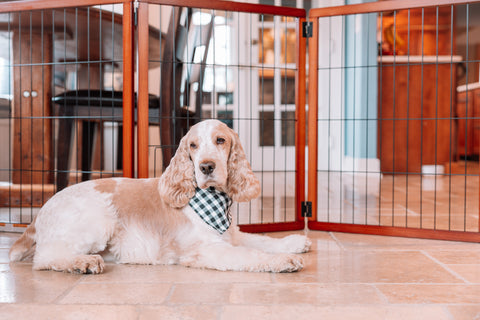Many dogs like jumping up on people. While this may be cute for puppies or small dogs; most people would rather train their dogs to stop jumping. This habit can be painful, embarrassing, or even dangerous in the case of a big dog!
While training your dog to stop jumping isn’t difficult, many people struggle because it requires consistency. Here’s an easy step-by-step plan for how to train your dog to stop jumping.

Start with these training steps
-
Don’t reward jumping at any age. Giving your dog or puppy attention – any attention – when she jumps up only rewards the behavior. Kneeing your dog, pushing her down, scolding her, telling her “no,” telling her to “sit,” or any attention at all is what your dog wants.
- I teach jumping and hugging as a trick later in life, but only after the dog has learned not to jump on people.
-
Pretend that the jumping dog doesn’t exist at all! Look up and away, cross your arms, and turn and leave the jumping dog. Don’t just turn your back; I mean walk away. Using dog gates or pet pens to subdivide your home will help a lot here so you actually can put a barrier between you and the jumping dog.
-
Instead of trying to teach your dog to sit, choose a more species-appropriate greeting. Forcing your dog to sit when she greets you or anyone else isn’t normal dog behavior. It doesn’t allow her to circle, wag, sniff, and move away when she’s ready. Letting a dog wiggle and stand is going to be far easier and more normal for your dog while still avoiding the jumping problem! Aim to teach your dog to keep all 4 paws on the floor rather than a stationary sit.
-
Teach your dog a gentle greeting behavior when the dog is calm. When you come home from a long day at work isn’t the time to train your dog to calmly greet you! She’s just too excited to succeed here. Set your dog up behind a gate when she’s nice and calm, then approach the gate and practice having your dog wait at the gate with all 4 paws on the floor. If she jumps on the gate, walk away. If she stays with all 4 paws on the ground, move closer and toss a treat on the ground. Make sure you put the treat on the ground – this helps keep her focus low.
-
Add challenges systematically and slowly. Eventually, you’ll enter the gated area and continue rewarding your dog for continuing to stand and wag. Gradually add more excitement to the picture with different people or while you’re carrying something interesting. Keep using gates and pet pens to build success. People can only enter the gated area if your dog is calmly waiting. If your dog jumps, the people leave.
-
Only let your dog-in-training greet known people. If you don’t know that someone else is up-to-date on your training plan, don’t let your pup go say hi (or let that person come pet your dog)! Letting your dog drag you over to them and trying to train the person and the dog at the same time is a recipe for frustration. Instead, practice with family members and friends who have already been told the game plan outlined in steps 4 and 5.
-
Ensure your dog’s needs are being well met. Bored, lonely, underexercised dogs are going to be much more challenging to train for this behavior. Make sure you’re spending ample time playing with your dog and meeting their social and physical needs. Otherwise, you’re asking a starving man to have table manners.



